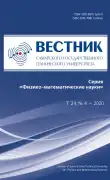Связанная нестационарная задача термоэлектроупругости для длинного полого цилиндра
- Авторы: Шляхин Д.А.1, Кальмова М.А.1
-
Учреждения:
- Самарский государственный технический университет
- Выпуск: Том 24, № 4 (2020)
- Страницы: 677-691
- Раздел: Статьи
- URL: https://journals.eco-vector.com/1991-8615/article/view/60880
- DOI: https://doi.org/10.14498/vsgtu1781
- ID: 60880
Цитировать
Полный текст
Аннотация
Построено новое замкнутое решение связанной нестационарной задачи термоэлектроупругости для длинного пьезокерамического радиально поляризованного цилиндра при удовлетворении на его лицевых поверхностях граничных условий теплопроводности 1-го и 3-го рода. Рассматривается случай, когда скорость изменения температурного поля не оказывает влияние на инерционные характеристики упругой системы, что позволяет включить в исходные расчетные соотношения рассматриваемой задачи линейные уравнения равновесия, электростатики и теплопроводности относительно радиальной компоненты вектора перемещений, электрического потенциала, а также функции изменения температурного поля. В расчетах применяется классический закон теплопроводности Фурье.Для решения задачи используется математический аппарат неполного разделения переменных в виде обобщенного биортогонального конечного интегрального преобразования, основанного на многокомпонентном соотношении собственных вектор-функций двух однородных краевых задач. Важным моментом в процедуре структурного алгоритма данного метода является выделение сопряженного оператора, без которого невозможно осуществить решение несамосопряженных линейных задач математической физики.Построенные расчетные соотношения дают возможность определить напряженно-деформированное состояние, температурное и электрическое поля, индуцируемые в пьезокерамическом элементе при произвольном температурном внешнем воздействии. Анализ численных результатов позволяет определить толщину стенки цилиндра, при которой электрическое поле приводит к перераспределению температурного поля. Установлено, что скорость изменения объема пьезокерамического тела при внешнем температурном воздействии не оказывает существенного влияния на температурное поле.Разработанный алгоритм расчета находит свое применение при проектировании нерезонансных пьезоэлектрических датчиков температуры.
Об авторах
Дмитрий Аверкиевич Шляхин
Самарский государственный технический университет
Email: d-612-mit2009@yandex.ru
доктор технических наук, доцент
Мария Александровна Кальмова
Самарский государственный технический университет
Email: kalmova@inbox.ru
без ученой степени, без звания
Список литературы
- Козлов В. Л., Оптоэлектронные датчики, Белорус. гос. ун-т, Минск, 2005, 116 с.
- Кульчин Ю. Н., Распределенные волоконно-оптические измерительные системы, Физматлит, М., 2001, 272 с.
- Дмитриев С. А., Слепов Н. Н., Волоконно-оптическая техника: современное состояние и новые перспективы, Техносфера, М., 2010, 608 с.
- Паньков А. А., "Резонансная диагностика распределения температуры пьезоэлектролюминесцентным оптоволоконным датчиком по решению интегрального уравнения Фредгольма", Вестник Пермского национального исследовательского политехнического университета. Механика, 2018, № 2, 72-82
- Abbas I. A., Youssef H. M., "Finite element analysis of two-temperature generalized magneto-thermoelasticity", Arch. Appl. Mech., 79:10 (2009), 917-925
- He T., Tian X., Shen Y., "A generalized electromagneto-thermoelastic problem for an infinitely long solid cylinder", Eur. J. Mech. a/Solids, 24:2 (2005), 349-359
- Abbas I. A., Zenkour A. M., "LS model on electro-magneto-thermoelastic response of an infinite functionally graded cylinder", Compos. Struct., 96 (2013), 89-96
- Ватульян А. О., Кирютенко А. Ю., Наседкин А. В., "Плоские волны и фундаментальные решения в линейной термоэлектроупругости", ПМТФ, 37:5 (1996), 135-142
- Ватульян А. О., Нестеров С. А., "Динамическая задача термоэлектроупругости для функционально-градиентного слоя", Вычислительная механика сплошных сред, 10:2 (2017), 117-126
- Коваленко А. Д., Введение в термоупругость, Наук. думка, Киев, 1965, 204 с.
- Шляхин Д. А., Даулетмуратова Ж. М., "Нестационарная осесимметричная задача термоупругости для жесткозакрепленной круглой пластины", Инженерный журнал: наука и инновации, 2018, № 78, 1-18
- Шляхин Д. А., Даулетмуратова Ж. М., "Нестационарная связанная осесимметричная задача термоупругости для жесткозакрепленной круглой пластины", Вестник Пермского национального исследовательского политехнического университета. Механика, 2019, № 4, 191-200
- Лычев С. А., Манжиров А. В., Юбер С. В., "Замкнутые решения краевых задач связанной термоупругости", Изв. РАН. МТТ, 2010, № 4, 138-154
- Радаев Ю. Н., Таранова М. В., "Волновые числа термоупругих волн в волноводе с теплообменом на боковой стенке", Вестн. Сам. гос. техн. ун-та. Сер. Физ.-мат. науки, 2011, № 2(23), 53-61
- Гринченко В. Т., Улитко А. Ф., Шульга Н. А., Механика связанных полей в элементах конструкций, Наук. думка, Киев, 1989, 279 с.
- Сеницкий Ю. Э., "Биортогональное многокомпонентное конечное интегральное преобразование и его приложение к краевым задачам механики", Изв. вузов. Матем., 1996, № 8, 71-81
- Кобзарь В. Н., Фильштинский Л. А., "Плоская динамическая задача связанной термоупругости", ПММ, 72:5 (2008), 842-851
Дополнительные файлы







